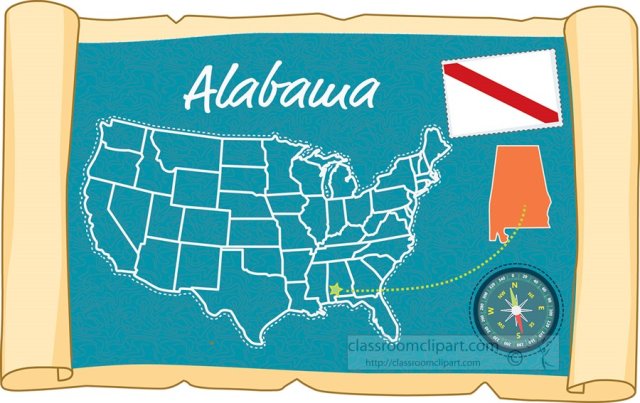Alabama State Encyclopedia Article Facts History and Quiz
Discover Alabama’s geography history landmarks culture famous people and test your knowledge with our quiz in this comprehensive encyclopedia article.

Introduction
Alabama, known as the Heart of Dixie, lies in the southeastern United States. From the Appalachian foothills in the north to the Gulf Coast’s sandy beaches in the south, Alabama’s landscapes range from rolling farmlands to coastal marshes. Rich in Native American heritage, Civil War history, and pivotal civil rights milestones, the state blends tradition with innovation in industries such as aerospace, automotive manufacturing, and agriculture.
Quick Fact Box
- Statehood: December 14, 1819 (22nd state)
- Capital: Montgomery
- Largest City: Birmingham
- Nickname: The Heart of Dixie; Cotton State
- Motto: Audemus jura nostra defendere (We Dare Defend Our Rights)
- Area: 52,419 mi²
- Population: ~5.0 million (2020 census)
- Highest Point: Cheaha Mountain (2,413 ft)
- Lowest Point: Gulf of Mexico (0 ft)
- State Bird: Yellowhammer
- State Flower: Camellia
- State Tree: Longleaf Pine
Where in the USA
Alabama is bordered by Tennessee to the north, Georgia to the east, Florida and the Gulf of Mexico to the south, and Mississippi to the west. Its northern region features the southern edge of the Appalachian Mountains, while central Alabama encompasses the Coosa–Tallapoosa River Valley. The Black Belt, known for its dark, fertile soils, runs across the central part of the state, and the Gulf Coastal Plain spreads along the southern edge.
Landmarks and Attractions
Alabama’s landmarks include the U.S. Space & Rocket Center in Huntsville, home to the Saturn V rocket exhibit and interactive astronaut experiences. In Birmingham, the Birmingham Civil Rights Institute tells the story of the 1960s movement. The Edmund Pettus Bridge in Selma commemorates the 1965 voting-rights marches. Gulf Shores and Orange Beach offer white-sand beaches and coastal wildlife refuges, while Little River Canyon in northeastern Alabama features scenic rapids and waterfalls.
State Symbols & Emblems
The yellowhammer—chosen for its bright plumage—reflects Alabama’s nickname during the Civil War. The longleaf pine, once widespread, is the state tree and vital for native wildlife. The camellia’s glossy leaves and winter blooms make it a symbol of resilience. Official emblems also include the Alabama red-bellied turtle (state reptile) and the monarch butterfly (state insect), highlighting the state’s commitment to its natural heritage.
People, Culture & Economy
Alabama’s culture blends southern hospitality, music traditions, and hearty cuisine—barbecue, fried green tomatoes, and biscuits are regional staples. The state hosts the annual National Shrimp Festival in Gulf Shores and a vibrant blues scene in Muscle Shoals, where legendary recordings were made. Economically, aerospace in Huntsville, automotive assembly in Tuscaloosa and Montgomery, and poultry farming across the state drive growth. Biotech research at the HudsonAlpha Institute and renewable-energy initiatives further diversify the economy.
Famous People from the State
- Helen Keller: Author and advocate for people with disabilities
- Rosa Parks: Civil rights pioneer known as the “Mother of the Freedom Movement”
- Harper Lee: Pulitzer Prize–winning author of To Kill a Mockingbird
- Hank Williams: Influential country music singer-songwriter
- Lionel Richie: Grammy-winning singer and songwriter
- Channing Tatum: Actor and producer
- Cam Newton: NFL MVP quarterback
- Frederick L. Collins: Inventor in aviation and aerospace technologies
- Nat King Cole: Iconic jazz pianist and singer
- William A. Handley: Early civil engineer and founder of modern surveying in Alabama
Climate, Ecosystems & Conservation
Alabama has a humid subtropical climate: hot summers, mild winters, and abundant rainfall. Pine savannas and longleaf ecosystems support threatened species like the red-cockaded woodpecker. River systems such as the Mobile–Tensaw Delta form one of the nation’s largest wetland complexes, rich in biodiversity. Conservation efforts focus on wetland restoration, longleaf pine reforestation, and protection of migratory bird habitats along the Gulf Coast.
Government, Education & Everyday Life
Alabama’s government is led by a governor and a bicameral legislature meeting in Montgomery’s Capitol Complex. The University of Alabama in Tuscaloosa and Auburn University anchor higher education, while Alabama A&M and Tuskegee University serve as historic black land-grant institutions. Everyday life may include tailgating at college football games, fishing on the Tennessee River, or attending a county fair. Community churches, 4-H clubs, and local festivals foster civic engagement and tradition.
Fun Facts
- Alabama is home to the first Mardi Gras celebration in the United States (Mobile, 1703).
- The Saturn V rocket used in Apollo moon missions was built in Huntsville.
- The world’s first electric traffic light was installed in Detroit—but Alabama’s first was in 1912 in Birmingham.
- The University of Alabama’s football stadium is called “The Denny Chimes” and seats over 100,000 fans.
- Alabama produces more than half of the nation’s peanuts.
Vocabulary Words
- Delta: A landform at a river’s mouth where sediments accumulate, such as the Mobile–Tensaw Delta.
- Subtropical: A climate zone with hot summers and mild winters, typical of southern Alabama.
- Ecosystem: A community of living organisms interacting with their environment, like the longleaf pine savanna.
- Biodiversity: The variety of plant and animal life in a region, which is high in Alabama’s wetlands.
- Advocate: A person who speaks or writes in support of a cause, exemplified by Rosa Parks.


















































